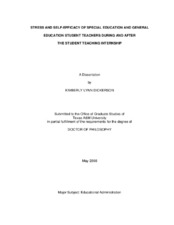| dc.contributor.advisor | Stanley, Christine A. | |
| dc.creator | Dickerson, Kimberly Lynn | |
| dc.date.accessioned | 2010-01-15T00:10:08Z | |
| dc.date.accessioned | 2010-01-16T00:50:56Z | |
| dc.date.available | 2010-01-15T00:10:08Z | |
| dc.date.available | 2010-01-16T00:50:56Z | |
| dc.date.created | 2008-05 | |
| dc.date.issued | 2009-05-15 | |
| dc.identifier.uri | https://hdl.handle.net/1969.1/ETD-TAMU-2699 | |
| dc.description.abstract | The purpose of this study was to determine if special education and
general education student teachers differed significantly in stress and selfefficacy
during and following the student teaching semester. The institutional
population was special education and general education student teachers at the
top ten teacher producing universities in Texas and the sample was drawn from
the four institutions which agreed to participate. Student teachers in these
institutions were emailed a link to the survey site. The pretest resulted in a
response rate of 16.5%, with 59 analyzable responses from participants. The
posttest resulted in a response rate of 10%, with 36 analyzable responses from
participants. Data from 23 student teachers completed the stress pretest and
posttest survey, and 22 student teachers completed the self-efficacy pretest and
posttest survey. Data were analyzed using Friedman’s ANOVA and Wilcoxon
Signed Ranks Test. The survey contained two instruments, the Teacher Stress Inventory, and
the Teacher Self-Efficacy Scale; and a researcher-developed demographic
information sheet. Student teachers were asked to respond to questions
pertaining to stress, as well as to how much influence student teachers have
with certain aspects of the learning environment. Data analysis utilized
descriptive and nonparametric inferential statistics to draw conclusions.
Among the major research findings were:
1. General and special education student teachers were significantly
more stressed and demonstrated higher levels of self-efficacy from
pretest to posttest.
2. Stress was most often caused by poorly motivated students and by
students not trying to the best of their abilities.
3. Self-efficacy was highest for the Disciplinary Self-Efficacy Subscale.
4. Special education student teachers did not differ significantly in either
stress or self-efficacy from pretest to posttest.
5. General education student teachers differed significantly in both stress
and self-efficacy from pretest to posttest.
The results of this study may provide a catalyst for further research
examining the interplay between stress and self-efficacy, specifically for special
education student teachers, and ultimately produce additional findings that may
inform student teacher curricula. Additionally, the results may help inform teacher preparation programs about methods to help mediate stress in the early
stages of stress onset. | en |
| dc.format.medium | electronic | en |
| dc.format.mimetype | application/pdf | |
| dc.language.iso | en_US | |
| dc.subject | Stress | en |
| dc.subject | Self-Efficacy | en |
| dc.subject | Special Education | en |
| dc.subject | Student Teachers | en |
| dc.title | Stress and self-efficacy of special education and general education student teachers during and after the student teaching internship | en |
| dc.type | Book | en |
| dc.type | Thesis | en |
| thesis.degree.department | Educational Administration and Human Resource Development | en |
| thesis.degree.discipline | Educational Administration | en |
| thesis.degree.grantor | Texas A&M University | en |
| thesis.degree.name | Doctor of Philosophy | en |
| thesis.degree.level | Doctoral | en |
| dc.contributor.committeeMember | Cole, Bryan | |
| dc.contributor.committeeMember | Elbert, Chanda | |
| dc.contributor.committeeMember | Tolson, Homer | |
| dc.type.genre | Electronic Dissertation | en |
| dc.type.material | text | en |
| dc.format.digitalOrigin | born digital | en |


